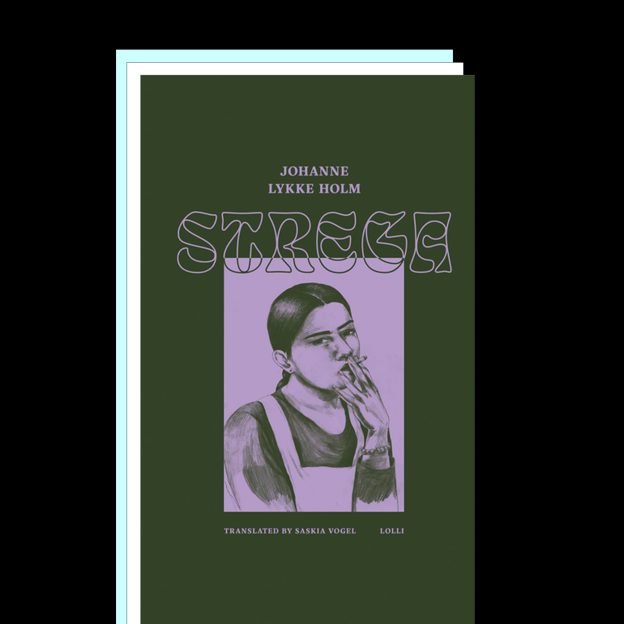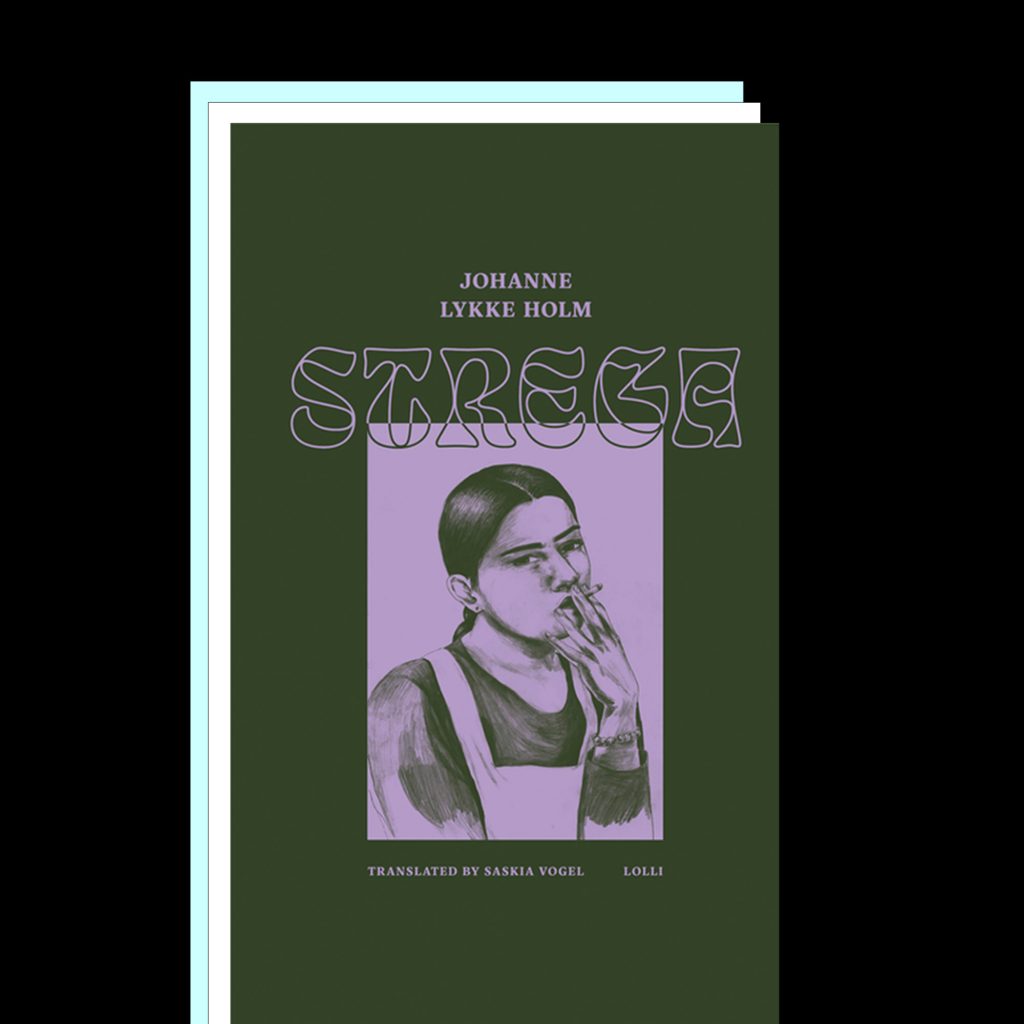
Strega — Johanne Lykke Holm
by
Johanne Lykke Holm and translator Saskia Vogel delivered a red-tinted memorial to the unjust murders of young women in this gothic construction of a dying terrarium. This novel is doused with poison, and wrenching with the artificiality of small things.
Nine young women arrive at the Olympic Hotel “on the other side of the forest, red and immovable,” tucked away in the mountains of Strega, “a mortuary beneath the trees.” Nine young women were sent to Strega by their families to become part of society, they were “put in safekeeping” to keep the desolate hotel and its rich porcelain figurines, gold-framed mirrors, and candelabras.
Rafa, the narrator, says, “I had cultivated a violent hatred against everything small and pleasant. I hated the ornate and diminutive. I hated dessert spoons and cigarette cases and compact mirrors.” The talismans that defined identity turn against the speaker, immersing her in everything “that is wrong with the world.” The nine girls find themselves in a doll house holding the small objects they brought with them.
Joyelle McSweeney writes that “the outlaying of a distressed and metastasized aesthetic field which forces up motifs and affects … for the sake of bringing into aesthetic immanence a suppressed political event is the signature of the Necropastoral.” The hotel itself is a ghost town where “no guests arrived.” The only neighbors are an elusive convent of nuns, eerie in their own presence and influence on the landscape and characters.
“On the other side of the building, where there was no shade and the sun shone the strongest, was the evil tillage … the death tillage. Even rows of wicked herbs, drinking and drinking of the broiling sun. We saw the whiteness running through them like poison. Oleander, belladonna, tobacco, and rosary pea. One could gather up a full arsenal of poison in that garden, feed someone the white sap from a small spoon made of gold.”
The girl’s turn to what is present around them, and divert the reader’s attention to Strega’s phantasmagoria framed by its environment:
“I turned my gaze to the dormitory. Three almost square windows with sparkling glass, reflecting the surrounding Virginia creeper. For a moment it was as if I could see my own face on the other side, a motionless phantom, forehead pressed to the glass.”
The speaker of this book is constantly asking the reader to look at the small objects they possess or clean, and the pastorals of the hotel, which serve to haunt and smother the faces of the hotel’s inhabitants. We look into the face of our murderer, but never recognize him. During a walk around the grounds, Rafa hears the Abbess say, “Sisters, there is an impression in the ground shaped like a female body. Look! A red smoke is rising from the hole and spreading.”
The landscape is a palimpsest, often layered with flowers, cool air, poison, and the haunting of dead girls. Their bodies and minds are mutated with the effect of violence. Red smoke suffocates the environment, appearing as an omen, and for Rafa, the shared fate of young women. She says, “I had a notion that the men were going to come to us. I had a notion about what would happen then, just as all women have this notion, that it’s only a matter of time.”
Holm’s consistent use of “One” as a pronoun affirms that “no person is ever just one thing.” Readers are invited to enter this space and break bread with the characters. At the Olympic, “they treated us as one body so we became one body.” Their dynamic was that of a coven, young women interested in spiritual and moral justice, precious things, and in sisterhood. This image is further allegorized in the threaded motif of Saint Quiteria–with symbolism that push themselves through the earth.
Quiteria is the name of the nine daughters who grew up in exile and sanctuary. They were discovered by the king (their father) and arranged to marry noble men. When they refused to renounce their faith and rebelled against their Roman Empire, Saint Quiteria was beheaded and thrown into the sea. She rose from the waves holding her head in her hands. The pastoral elements of the novel become infected with the living ghost of one of the nine girls. The reader is again directed to look at the objects she held in her hands.
“The Necropastoral is a political-aesthetic zone in which the fact of mankind’s depredations cannot be separated from an experience of nature” (McSweeney). For Rafa and the other young women at the Olympic, their experiences are seeping with poison, their surroundings are infected and symbolic of the deathly pastoral that runs parallel to the murder of women and their labor is canonized by what remains.
Readers never learn the truth, but they know it. The conflict of the novel arrives with an annual party at The Olympic, this is the turning point for the speaker and her friends. The party “was a festival of death, like the backside of the vernal equinox, a worship of the world’s every grave and sinkhole and poisonous plant.” On this night, what was once a communion of the saints becomes a night terror. A red smoke was everywhere after the death.
After the death, Rafa would see with black obsidian eyes.
After the death, one body would wander the forest like a ghost.
After the death, no guests came.
After the death, “It smelled of carnations and incense and frost,
winter burials in the mountains.”
After the death, the men searched and searched in the moonlight.
After the death, “We put a rosary pea in our uniform pocket.”
After the death, the relics appeared. Glittering, shimmering.
This novel captures the fraught dynamics between women, labor, land, and violence. Strega lays a blurred boundary between the living and the dead, both tethered by our talismans and communion with earthly things. Holm directs her readers to question these relationships and discover the aesthetics of the landscape as a structural conceit. Even when looking away, readers are diverted to look again at the small things that make up a person. The land they walk on. Their little belongings may symbolize class and labor and identity—but those items can never fully encompass the presence of being.
McSweeney, Joyelle. “What is the Necropastoral?” Poetry Foundation, 29 Apr. 2014, www.poetryfoundation.org/harriet-books/2014/04/what-is-the-necropastoral.
VALERIE VARGAS reviewer
Valerie Virginia Vargas is a Venezuelan American poet and printmaker from South Florida. Her work explores womanhood and her relationship to ecology, which manifests through fables and folklore, housework, desire, and magic. She is concerned with the boundaries between form and content, aesthetic and style, art and poetry. Some of her writings can be found in Jellyfish Magazine.
Lykke Holm, Johanne. Strega, trans. Saskia Vogel. Lolli Editions, 2021.
